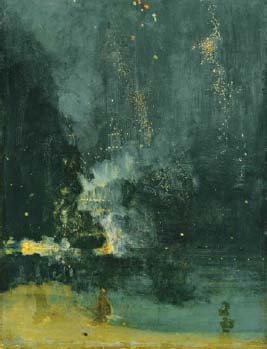From the Industrial Revolution to World War I, C. 1850–1914Late Nineteenth-Century Painting |
Why did Whistler go to court? |
James Abbott McNeill Whistler (18341903) is now most famous for a portrait of his mother in a rocking chair, but his work during the second half of the nineteenth century is notable for its increasing abstraction. Whistler was American, but spent the majority of his career in London and never returned to the United States after moving to that English city. His early paintings were influenced by Aestheticism and he painted many successful portraits, but he was interested in the idea of art as a visual music. He even named an 1862 portrait of a girl in a white dress, Symphony in White No. 1, to emphasize the musicality of his work. In his 1893 autobiography, The Gentle Art of Making Enemies, he wrote, “As music is the poetry of sound, so is painting the poetry of sight and the subject matter has nothing to do with harmony of sound or of color” (as quoted in Stokstad 885).
In 1875, Whistler shocked the world with his almost completely abstract painting, Nocturne in Black and Gold, also known as The Falling Rocket. Whistler was accused of having no clear subject for his work, and those who viewed it described it as looking unfinished. The painting personally enraged John Ruskin, Britain’s premier art critic, who accused the artist of throwing paint in the public’s face with such an abstract work. Whistler sued Ruskin for libel and soon Whistler found himself on the witness stand answering questions about his artistic intentions. When asked about the subject of the painting, Whistler explained that he was attempting an “artistic arrangement” and a “representation of fireworks over the town of Cremorne,” not a realistic visualization of the town. He further explained his support for the Aesthetic concept of “art for art’s sake.” Whistler won the trial, but received only a single farthing in damages, a reflection of the generally negative attitude about his work at the time. The episode also highlights the vigor with which artists and critics were debating the value of increased abstraction.

English art critic John Ruskin was so shocked by Whistler’s 1875 painting Nocturn in Black and Gold (the Falling Rocket) that he accused the artist of “flinging a pot of paint in the public’s face.” In return, Whistler sued the critic for libel.
